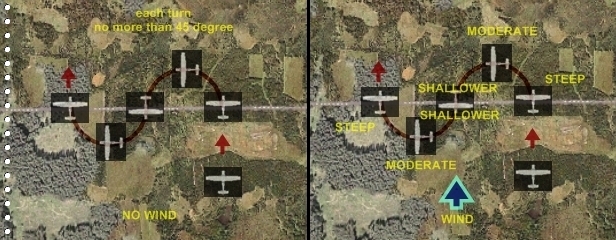 .home page .back Tutorials. GA Planes
.home page .back Tutorials. GA Planes
Once a pilot developed a sufficient skill to master and handle his plane, such a training will have developed his attention into that handling. Should the training keep like that at that stage, that skill might solidify into a fixed habit and detrimental to ease and safety in flight. To avoid that, a step into the training now is what is called 'ground reference maneuvers' or a flight performed in reference to neat ground landmarks, like a S turn about a straight road or railway, for example. Such maneuvers are meant to bring the pilot to show more divided attention during his pilotage as he will have to consider a ground track, beyond his aptitudes to simply controling the plane! Two such ground reference maneuvers will be taken in consideration, like the S and the eights across a road
A supplementary difficulty in the exercise comes when wind is added. With wind, any such maneuvers will have further to take any drift into account for correction. Wind indeed impacts on flight as it has the plane drifting from its intended path. Supposing we are flying to a given landmark, like a antenna (which as projected unto the ground, or 'ground track', would draw a straight line between our current position and the antenna) in the case of a sufficiently strong sidewind -which is the neatest case of wind drift- and with a constant heading, we will have our plane drifting into where the wind is pushing she, and eventually miss our landmark in that direction (and our ground track figuring a oblique line from our starting point). Like for example, at a heading 360, with a sidewind from the 270, we'll miss the antenna by the right. Or conversely. Generally, before any further consideration, the preferred method to compensate for a wind drift is to head the plane sufficiently into the wind to correct and thus maintain a intended ground path. The ground path that way remains a straight line to the point we intend to fly, albeit the nose of the plane is not turned to that point anymore. With our new exercises into ground reference maneuvers, we will have to perform those without, or with wind, which will add to our skill. Let's chose some airspace away from trafic or livestock and people on the ground, with a straight road or railtrack, and let's fly at a altitude of about 1,000ft AGL (with a awareness for any forced-landing field in case the event arises)
The ground track of that maneuver is two semicircles of equal radii each side of a selected straight road on the ground. The straight road may also be replaced with a fence, railroad, etc. For the purpose of the wind drift exercise, that line should also be perpendicular to the usual direction of the wind in the area. The maneuver is performed at a constant altitude after one cleared the area and a visual lookout for other aircraft performed during it unfolds. The maneuver is easy. Take a course perpendicular to the road and, when crossing it, just begin a first 180-degree turn. That will bring you back again perpendiculary to the road which, once crossed, you will immediately begin a new 180-degree turn -in the opposite direction- which again brings you back to the road. Any bank during the turns should not excede 45 degree. Just have the bank steady during each turn and about the same intensity for both at the effect that your ground track really be a symetric S about the road. Without wind, or with a negligeable one, just perform several times and check for your altitude and flight environment. As far as some wind drift comes into play, two methods may be used. A one, which is how the maneuver is teached in France, for example, is just to take the wind drift into account to keep having the S ground track symetric, which needs to control the bank accordingly. A second method, like the one in the USA, is more accurate with the principle that whatever turn is made off, or into the tailwind has to be steep. At the 90-degree mark relative to the road, the bank comes more moderate and when keeping turning into to or from any headwind, it must become shallower still. The varying bank of the turn compensate appropriately for the drift
 | S turns about a road without (left) and with (right) wind drift. The wind drift correction shown is the accurate one |
That variant needs the same skill and remarks as you will perform it about a straight road with a easily spotted point like a crossroad or any other mark. Also make your choice, like for the previous exercise, with the main road perpendicular to the usual direction of the wind. The exercise begins by flying over the road in one or the other direction. When flying over the point of reference, just begin a complete 360-degree turn in either direction. When by the end of the turn you're back over the mark, just perform another 360-degree in the opposite direction. When back again to the mark, you will have performed a 8-shaped ground track about the road! Altitude also has to remain constant during the maneuver and pilot must lookout for any trafic. Just perform several times. The remarks above about any wind drift are the same with a difference between a approximate or a accurate correction. For the accurate one, any turn from or into tailwind to be steep has to come steeper and the steepest when downwind as it turn shallower when closing the 90-degree mark, the shallowest reached when upwind
Website Manager: G. Guichard, site Lessons In Microsoft Flight Simulator / Leçons de vol pour les Flight Simulator de Microsoft, http://flightlessons.6te.net.htm. Page Editor: G. Guichard. last edited: 5/27/2013. contact us at ggwebsites@outlook.com